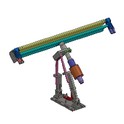As a supplier of 1000W ultrasonic generators, I've received numerous inquiries about the types of materials these powerful devices can grind. Ultrasonic technology has revolutionized various industries, offering a precise and efficient way to process a wide range of substances. In this blog post, I'll delve into the materials that can be effectively ground using a 1000W ultrasonic generator, highlighting the benefits and applications of this cutting - edge equipment.
How Ultrasonic Grinding Works
Before we explore the materials, it's essential to understand the principle behind ultrasonic grinding. A 1000W ultrasonic generator produces high - frequency electrical signals, which are then converted into mechanical vibrations by a transducer. These vibrations create cavitation bubbles in a liquid medium. When these bubbles collapse, they generate intense shockwaves and high - velocity microjets. The energy released during this process is powerful enough to break down particles, facilitating grinding and dispersion.
Materials Suitable for Grinding with a 1000W Ultrasonic Generator
1. Minerals
Minerals are one of the most common materials processed using ultrasonic grinding. For example, quartz, a hard and abundant mineral, can be ground to a fine powder using a 1000W ultrasonic generator. The high - energy shockwaves generated by the ultrasonic cavitation break the quartz crystals into smaller particles, which can be used in industries such as ceramics, glass manufacturing, and electronics.
Another mineral that can be effectively ground is feldspar. Feldspar is widely used in the production of ceramics, as it provides strength and stability to the final product. Ultrasonic grinding of feldspar ensures a more uniform particle size distribution, improving the quality of the ceramic products.
2. Metals and Metal Oxides
Metals and metal oxides can also be ground using a 1000W ultrasonic generator. Aluminum oxide, a common abrasive material, can be processed to achieve a specific particle size for use in grinding wheels, polishing compounds, and refractory materials. The ultrasonic grinding process can break down large aluminum oxide particles into finer grains, enhancing its abrasive properties.
Metals such as copper and silver can also be ground into fine powders. Ultrasonic grinding can be used to produce metal nanoparticles, which have unique physical and chemical properties compared to their bulk counterparts. These nanoparticles have applications in electronics, catalysis, and biomedical fields. For instance, silver nanoparticles are used in antibacterial coatings and conductive inks, while copper nanoparticles are used in electronics for their high conductivity.
3. Polymers
Polymers, including plastics and rubbers, can be ground using ultrasonic technology. Polyethylene, a widely used plastic, can be ground into small particles for recycling purposes. The ultrasonic grinding process can break down the polymer chains, reducing the particle size and making it easier to re - process the material.
Rubbers, such as natural rubber and synthetic rubbers, can also be ground to produce rubber powders. These powders can be used as fillers in various applications, such as asphalt modification, where they improve the performance and durability of the asphalt.
4. Biological Materials
Biological materials, such as plant cells and microorganisms, can be disrupted and ground using a 1000W ultrasonic generator. In the pharmaceutical industry, ultrasonic grinding is used to extract bioactive compounds from plant materials. The high - energy shockwaves break the cell walls of the plants, releasing the desired compounds.
Microorganisms, such as bacteria and yeast, can also be lysed using ultrasonic technology. This is useful in biotechnology for the extraction of proteins, enzymes, and DNA. The 1000W ultrasonic generator provides enough energy to break the cell membranes of the microorganisms, allowing for the isolation of the intracellular components.
Benefits of Using a 1000W Ultrasonic Generator for Grinding
- Precision: Ultrasonic grinding offers precise control over the particle size distribution. The high - energy cavitation process can be adjusted to produce particles within a specific size range, ensuring consistent quality in the final product.
- Efficiency: The 1000W power output of the ultrasonic generator allows for rapid grinding and dispersion. Compared to traditional grinding methods, ultrasonic grinding can achieve the desired particle size in a shorter time, reducing production time and costs.
- Uniformity: The ultrasonic grinding process ensures a more uniform particle size distribution. This is crucial in industries where the quality and performance of the product depend on the particle size, such as in the production of pharmaceuticals and electronics.
Other Ultrasonic Generator Options
In addition to the 1000W ultrasonic generator, we also offer 3000W Ultrasonic Generator and 500W Ultrasonic Generator. The 3000W ultrasonic generator provides even higher power for more demanding applications, such as large - scale industrial grinding. On the other hand, the 500W ultrasonic generator is suitable for smaller - scale research and development projects or applications where less power is required.
Contact Us for Purchasing and Consultation
If you are interested in our 1000W Ultrasonic Generator or have any questions about the materials that can be ground using ultrasonic technology, please feel free to contact us. Our team of experts is ready to provide you with detailed information and support to help you choose the most suitable equipment for your specific needs. Whether you are in the minerals, metals, polymers, or biological materials industry, our ultrasonic generators can offer an efficient and effective solution for your grinding requirements.


References
- Mason, T. J., & Lorimer, J. P. (2002). Applied Sonochemistry: Uses of Power Ultrasound in Chemistry and Chemical Engineering. Wiley.
- Suslick, K. S., & Flannigan, D. J. (2008). Applications of Ultrasound to Materials Chemistry. Accounts of Chemical Research, 41(12), 1687 - 1695.
- Zhang, L., & Li, Y. (2010). Ultrasonic - assisted grinding and dispersion of nanomaterials. Journal of Nanoparticle Research, 12(4), 1201 - 1208.






